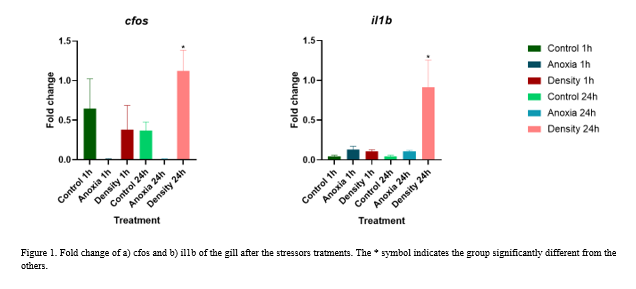NEUROENDOCRINE STRESS RESPONSE TO STRESSORS OF DIFFERENT SEVERITY IN THE MUCOUSAL TISSUES OF Sparus aurata
Introduction
It is known that fish are subjected to different stressors in the aquaculture industry such as anoxia or density. These stressors can activate a stress response, but t he level of this response will depend on the s everity of the stressor. Such severity may be due to different factors such as the species studied, the age , or duration, intensity and type of stressors among other factors. In this case it was selected a stressor of high severity such as anoxia where the fish must be out of the water, and a crowding stress which is less severe than anoxia. Moreover, crowding stress has an additional emotional component that anoxia does not have. Also, the stress response can modulate other responses such as the immune or the endocrine and energetic response that can also have further effects on fish health. This is why the aim of this study was to investigate the neuroendocrine stress response of a juvenile s of S.aurata subjected to two different severe stressors such as anoxia and crowding to understand how the severity can modulate the activation level of the response. Also, another objective was to observe if the recovery time was affected by the severity of the stressor.
Materials and methods
A total of 48 g ilthead seabream juveniles were acclimated to AQUAB fish facilities (Universitat Autònoma de Barcelona, UAB), After the acclimation period, f ish were randomly divided in 3 different treatment groups; control, anoxia, and crowding group that were sampled at 1 and 24 h after the stressor . The fish subj ected to anoxia were exposed to air for 3 min and then were placed back in thanks for 1 hour or 24 hours until the sampling. The crowding stress was performed by decreasing the water level from 20 L to 10 L, remaining like this for 30 min and then restoring the water volume, and wait until sampling at 1 or 24 hours. From each fish, plasma was sampled for haematological and biochemical analysis, and the mucosal tissues (gills, s kin, and gut) were sampled for qPCR gene expression analysis .
Results
No differences were found in cortisol levels in plasma, but the parameters related with the oxidative stress changed in the groups subjected to stress compared with controls. Regarding the gene expression results, it was observed a tissue-specific response, being the gills the most affected one . What was relevant is that glucocorticoids receptors did not show any difference compared with the control, but in the case of cfos gene there was an upregulation that can be clearly associated to the stress response. Moreover , the genes related with the immune and the oxidative stress were also affected. Another interesting discovery was that crowding stress showed more effects than anoxia, and the effects from the density lasted for longer time in the fish.
Discussion
As it was expected different severities had different effects on the fish (Figure 1), since anoxia did not cause the upregulation of cfos , but the crowding stress caused an upregulation but after 24 hours. Despite glucocorticoids receptors were not significantly regulated, il1β in the case of the crowding group at 24h suffered an upregulation and an interesting fact is that the anoxia exposure did not affect the immune genes in gills. Also it is relevant to remark the tissue specific response, as this could be due to the exposure of each tissue to the stressors and the main function of the tissue . In the case of gills and the skin both tissues are in direct contact with the environment but the main specific function of each tissue is completely different which may explain the different sensitivity of the response
